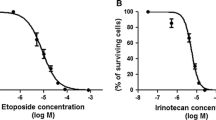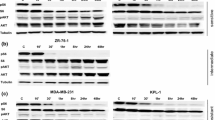Summary
Tamoxifen has been shown to inhibit the proliferation of human gliomasin vitro. This inhibition is independent of tamoxifen's known anti-estrogenic properties. Tamoxifen is an inhibitor of protein kinase C (PKC), a calcium- and phospholipid-dependent serine kinase which plays a critical role in the proliferation of certain cell lines. Gliomas overexpress PKC, and their growth rate is coupled to the level of this key enzyme. As such, the effect of tamoxifen may be mediated by its inhibitory effect on PKC. To further investigate this possibility, we compared the chemosensitivity of cultured glioma lines to both tamoxifen and N-desmethyltamoxifen (DMT). DMT is the major metabolite of tamoxifen in humans and is a ten-fold more potent inhibitor of PKC. Seven lines were tested using the standard MTT assay, which quantitates metabolically active cells colorimetrically using a tetrazolium dye. Four of the seven lines were also tested using a tritiated thymidine uptake assay. In the MTT assay, all seven lines showed significantly greater sensitivity to DMT, while three of the four lines tested in the thymidine uptake assay were more sensitive to DMT. Correlation between the two assays was good. The dose of tamoxifen required to produce a 50% inhibition of optical absorbance or thymidine uptake (ID50) was typically five- to ten-fold greater than the ID50 for DMT, approximating the relative strength of the two compounds as PKC inhibitors. In addition to providing some support for the ypothesis that triphenylethylenes inhibit gliomas via PKC inhibition, these findings have clinical significance. Levels of DMT in serum, brain and brain metastases are about twice the comparable levels of tamoxifen during chronic therapy. DMT achieved complete inhibition of all seven glioma lines at concentrations of 200 ng/ml. Levels as high as 2000 ng/g can be achieved in tumor tissue, suggesting that chronic tamoxifen therapy may have some role in the therapy of these aggressive tumors.
Similar content being viewed by others
References
Nishizuka Y: Studies and perspectives in protein kinase C. Science 233: 305–312, 1986
Reifenberger G, Deckert M, Weschler W: Immunohistochemical determination of protein kinase C expression and proliferative activity in human brain tumors. Acta Neuropath 78: 166–175, 1989
Todo T, Shitara N, Nakamura H, Takakura K, Ikeda K: Immunohistochemical determination of protein kinase C isoenzymes in human brain tumors. Neurosurgery 29: 399–404, 1991
Couldwell WT, Antel JP, Apuzzo MLJ, Yong VW: Enhanced protein kinase C activity correlates with growth rates of malignant human gliomas. Neurosurgery 29: 880–887, 1991
Pollack IF, Randall MS, Kristofik MP, Kelly RH, Selker RG, Vertosick FT: Response of malignant glioma lines to activation and inhibition of protein kinase C-mediated pathways. J Neurosurg 73: 98–105, 1990
Couldwell WT, Antel JP, Yong VW: Enhanced protein kinase C activity correlates with the growth rate of malignant gliomas: Part II. Effects of glioma mitogens and modulators of PKC. Neurosurgery 31: 717–724, 1992
O'Brian CA, Liskamp RM, Solomon DH, Weinstein IB: Inhibition of protein kinase C by tamoxifen. Cancer Res 45: 2462–2465, 1985
O'Brian CA, Liskamp RM, Solomon DH, Weinstein IB: Triphenylethylenes: a new class of protein kinase C inhibitors. J Natl Cancer Inst 76: 1243–1246, 1986
Legha SS: Tamoxifen in the treatment of breast cancer. Ann Intern Med 109: 219–228, 1988
Pollack IF, Randall MS, Kristofik MP, Kelly RH, Selker RG, Vertosick FT: Effect of tamoxifen on DNA synthesis and proliferation of human malignant glioma linesin vitro. Cancer Res 50: 7134–7138, 1990
Cole SPC: Rapid chemosensitivity testing of human lung tumor cells using the MTT assay. Cancer Chemother Pharmacol 17: 259–263, 1986
Denziot F, Lang R: Rapid colorimetric assay for cell growth and survival. Modifications to the tetrazolium dye procedure giving improved sensitivity and reliability. J Immunol Methods 89: 271–277, 1986
Alley MC, Scudero DA, Monis A, Hursey ML: Feasibility of drug screening with panels of human tumor cell lines using a microculture tetrazolium assay. Cancer Res 48: 589–601, 1988
Heo DS, Park JG, Hata K, Day R, Herberman RB, Whiteside TL: Evaluation of tetrazolium-based semiautomatic colorimetric assay for measurement of human anti-tumor cytotoxicity. Cancer Res 50: 3681–3690, 1990
Pollack IF, Randall MS, Kristofik MP, Kelly RH, Selker RG, Vertosick FT: Response of malignant glioma lines to epidermal growth factor and platelet-derived growth factor in a serum-free medium. J Neurosurg 73: 106–112, 1990
Pollack IF, Randall MS, Kristofik MP, Kelly RH, Selker RG, Vertosick FT: Response of low-passage human malignant gliomasin vitro to stimulation and selective inhibition of growth-factor-mediated pathways. J Neurosurg 75: 284–293, 1991
Lam HYP: Tamoxifen is a calmodulin antagonist in the activation of cAMP phosphodiesterase. Biochem Biophys Res Commun 118: 27–32, 1984
Shacoori V, Leray G, Guenet L, Gueble-Val F, Le Traut A, Le Gall JY: Inhibition of (Na+, K+)-ATPase and Mg++-AT-Pase by a lysmotropic drug: perihexilene maleate. Res Commun Chem Pathol Pharmacol 59: 161–172, 1988
Lien EA, Solheim E, Ueland PM: Distribution of tamoxifen and its metabolites in rat and human tissues during steady-state treatment. Cancer Res 51: 4837–4844, 1991
Vertosick FT, Selker RG, Pollack IF, Arena V: The treatment of intracranial malignant gliomas using orally administered tamoxifen therapy: preliminary results in a series of ‘failed’ patients. Neurosurgery 30: 897–903, 1992
Couldwell WT, Weiss MH, DeGiorgio CM, Weiner LP, Hinton DR, Ehresmann GR, Conti PS, Apuzzo MLJ: Clinical and radiographic response in a minority of patients with recurrent malignant gliomas treated with high-dose tamoxifen. Neurosurgery 32: 485–490, 1993
Author information
Authors and Affiliations
Rights and permissions
About this article
Cite this article
Vertosick, F.T., Selker, R.G., Randall, M.S. et al. A comparison of the relative chemosensitivity of human gliomas to tamoxifen and n-desmethyltamoxifenin vitro . J Neuro-Oncol 19, 97–103 (1994). https://doi.org/10.1007/BF01306450
Issue Date:
DOI: https://doi.org/10.1007/BF01306450




